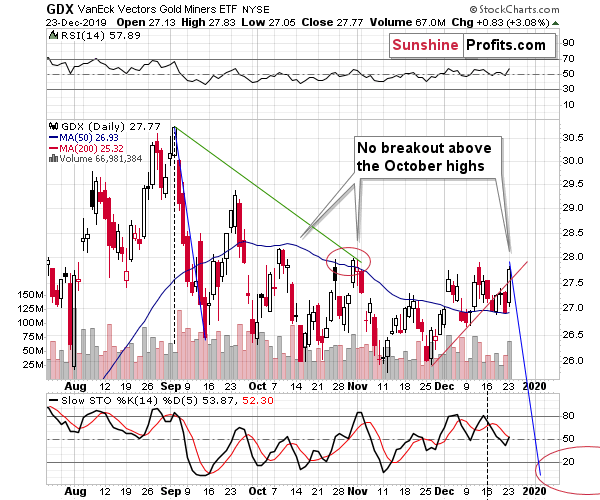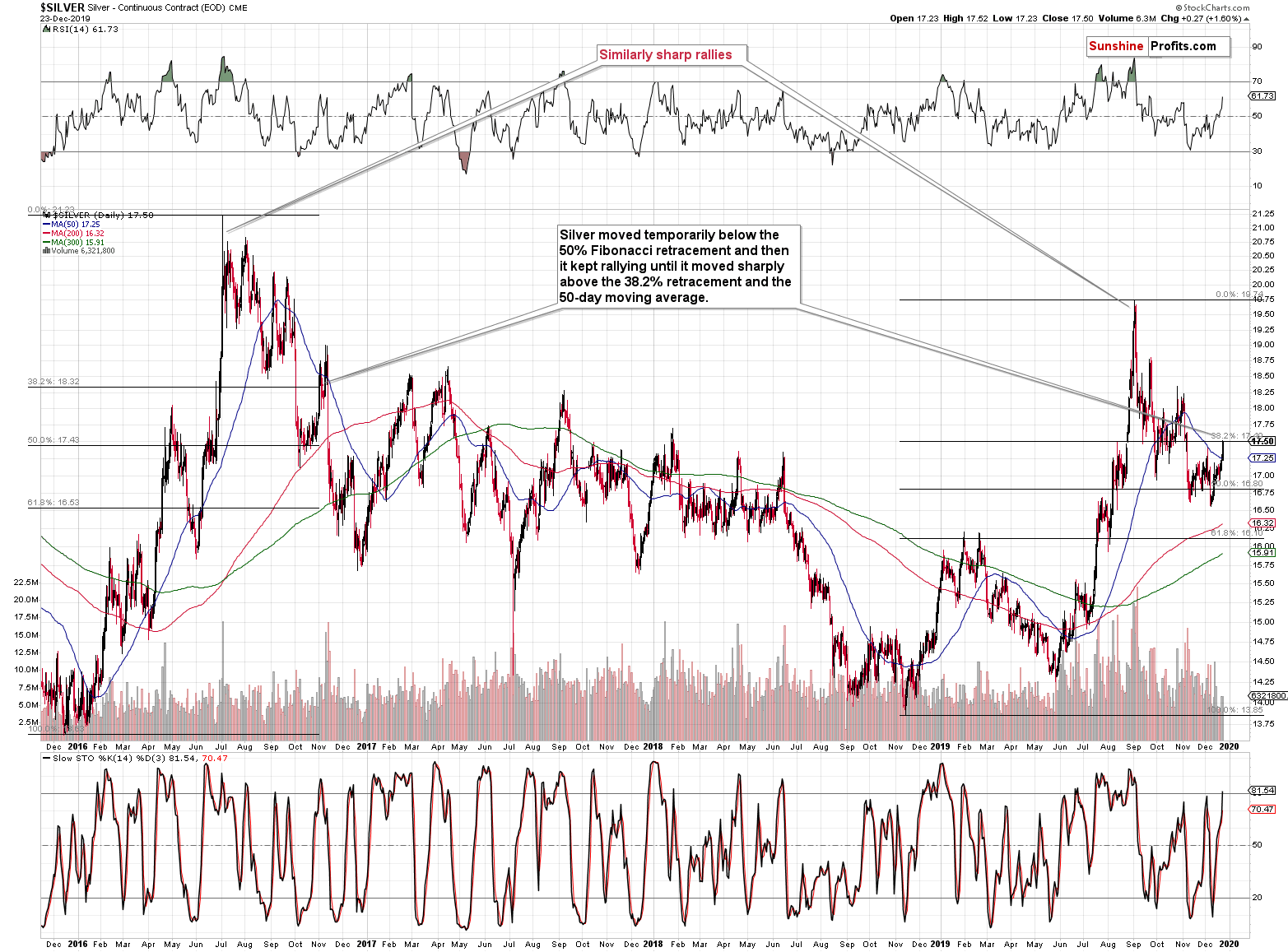Briefly: in our opinion, full (250% of the regular size of the position) speculative short position in gold, silver, and mining stocks is justified from the risk/reward point of view at the moment of publishing this Alert.
In yesterday's Alert, we wrote that there will be no regular Alerts until Friday, but given what happened in miners yesterday and what's happening in silver today, we think you would really appreciate a more detailed update.
We already wrote about the move higher in gold and silver in yesterday's regular Gold & Silver Trading Alert, but since we published it before the US session opened, it was not possible for us to comment on yesterday's performance in the miners. That's something you might be very interested in, because the miners showed daily strength, and closed a new monthly high. There was no intraday high, though.
In short, it's too early to say if this was a short-term game-changer. On one hand the short-term breakdown was invalidated, but on the other hand, the daily strength and volume that accompanied it are very similar to the Dec 3, and Dec 11 sessions. The first one was the local top and the second one preceded the top by one day. Moreover, GDX may have closed at monthly high, but it's below the two October highs, so it's too early to say that we saw a major breakout.
Additionally, yesterday's session might have been an example of the final part of a big move that can be characterized by a very brief comeback miners' strength after a period of underperformance. This doesn't invalidate the points that we made previously regarding miners' weakness. What would invalidate them is a prolonged situation in which miners are showing significant strength, while silver doesn't show exceptional short-term strength.
And silver is definitely showing exceptional very short-term strength here, also during today's pre-market trading.
Another thing worth looking at in case of the silver market is how similar its price movement has recently been to what we saw in 2016. Silver erased a bit more than 50% of the previous rally and then it started to climb higher. The late-2016 corrective upswing ended once silver moved to the pre-slide low (the late-September 2016 bottom). The analogous bottom in this case is the late-October 2019 lows of about $17.60. In today's pre-market trading, silver moved to about $17.70, so it could be the case that the rally is already over. However, knowing how volatile silver can be at times, it could be the case that it moves even higher in the very short term, before topping.
Summing up, we are not adjusting our trading positions at this time, but we are closely watching what's going on and we are prepared for closing the positions if we see more bullish signs. Why not close them right away? So that we don't risk missing the profits from the volatile slide like the ones that often follow silver's very short-term strength. Please note that while the move doesn't have to be exactly the same, in November 2016, after a rally similar to the current one, silver declined about 10% in just 2 days.
The next regular Gold & Silver Trading Alert is scheduled for Friday, but if anything major happens, we'll keep you updated.
To summarize:
Trading capital (supplementary part of the portfolio; our opinion): Full speculative short position (250% of the full position) in gold, silver, and mining stocks is justified from the risk/reward perspective with the following stop-loss orders and binding exit profit-take price levels:
- Gold futures: profit-take exit price: $1,391; stop-loss: $1,573; initial target price for the DGLD ETN: $36.37; stop-loss for the DGLD ETN: $25.44
- Silver futures: profit-take exit price: $15.11; stop-loss: $19.06; initial target price for the DSLV ETN: $24.88; stop-loss for the DSLV ETN: $14.07
- Mining stocks (price levels for the GDX ETF): profit-take exit price: $23.21; stop-loss: $30.11; initial target price for the DUST ETF: $14.69; stop-loss for the DUST ETF $6.08
In case one wants to bet on junior mining stocks' prices, here are the stop-loss details and target prices:
- GDXJ ETF: profit-take exit price: $30.32; stop-loss: $44.22
- JDST ETF: profit-take exit price: $35.88 stop-loss: $11.68
Long-term capital (core part of the portfolio; our opinion): No positions (in other words: cash)
Insurance capital (core part of the portfolio; our opinion): Full position
Whether you already subscribed or not, we encourage you to find out how to make the most of our alerts and read our replies to the most common alert-and-gold-trading-related-questions.
Please note that the in the trading section we describe the situation for the day that the alert is posted. In other words, it we are writing about a speculative position, it means that it is up-to-date on the day it was posted. We are also featuring the initial target prices, so that you can decide whether keeping a position on a given day is something that is in tune with your approach (some moves are too small for medium-term traders and some might appear too big for day-traders).
Plus, you might want to read why our stop-loss orders are usually relatively far from the current price.
Please note that a full position doesn't mean using all of the capital for a given trade. You will find details on our thoughts on gold portfolio structuring in the Key Insights section on our website.
As a reminder - "initial target price" means exactly that - an "initial" one, it's not a price level at which we suggest closing positions. If this becomes the case (like it did in the previous trade) we will refer to these levels as levels of exit orders (exactly as we've done previously). Stop-loss levels, however, are naturally not "initial", but something that, in our opinion, might be entered as an order.
Since it is impossible to synchronize target prices and stop-loss levels for all the ETFs and ETNs with the main markets that we provide these levels for (gold, silver and mining stocks - the GDX ETF), the stop-loss levels and target prices for other ETNs and ETF (among other: UGLD, DGLD, USLV, DSLV, NUGT, DUST, JNUG, JDST) are provided as supplementary, and not as "final". This means that if a stop-loss or a target level is reached for any of the "additional instruments" (DGLD for instance), but not for the "main instrument" (gold in this case), we will view positions in both gold and DGLD as still open and the stop-loss for DGLD would have to be moved lower. On the other hand, if gold moves to a stop-loss level but DGLD doesn't, then we will view both positions (in gold and DGLD) as closed. In other words, since it's not possible to be 100% certain that each related instrument moves to a given level when the underlying instrument does, we can't provide levels that would be binding. The levels that we do provide are our best estimate of the levels that will correspond to the levels in the underlying assets, but it will be the underlying assets that one will need to focus on regarding the signs pointing to closing a given position or keeping it open. We might adjust the levels in the "additional instruments" without adjusting the levels in the "main instruments", which will simply mean that we have improved our estimation of these levels, not that we changed our outlook on the markets. We are already working on a tool that would update these levels on a daily basis for the most popular ETFs, ETNs and individual mining stocks.
Our preferred ways to invest in and to trade gold along with the reasoning can be found in the how to buy gold section. Additionally, our preferred ETFs and ETNs can be found in our Gold & Silver ETF Ranking.
As a reminder, Gold & Silver Trading Alerts are posted before or on each trading day (we usually post them before the opening bell, but we don't promise doing that each day). If there's anything urgent, we will send you an additional small alert before posting the main one.
Thank you.
Sincerely,
Przemyslaw Radomski, CFA
Editor-in-chief, Gold & Silver Fund Manager





